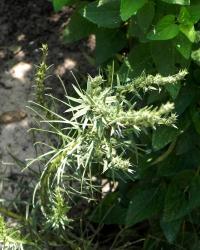The USDA county level maps can give a good general impression of the range of a plant, but they are far from comprehensive so it doesn't pay to take them too literally. Your plant is clearly either Liatris punctata var. mucronata (Liatris mucronata), Liatris aestivalis, or maybe Liatris glandulosa.
Liatris aestivalis and Liatris glandulosa were just recently, within the last decade or so, described as separate species from Liatris punctata. So, as you might imagine, they aren't very easy to tell apart. Liatris glandulosa can be distinguished from the other two by the glandular hairs on its stems which makes the plant feel sticky to the touch. The key that Jay linked to indicates that you have to have to look at the phyllaries (tiny leaf-like bracts at the base of each flower head) to distinguish Liatris punctata var. mucronata from Liatris aestivalis.
Your last picture shows the phyllaries quite well (the little spiky looking things where the flowers will develop), but I can't see them clearly enough to tell which species it might be. I don't see any hairs on the plant's stems, so it's probably not Liatris glandulosa, but again, I can't see it quite clearly enough to be certain.
